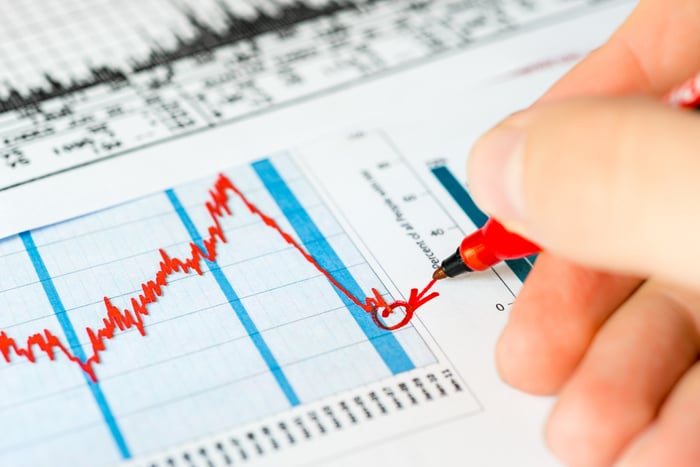We're in the homestretch of what looks to be another phenomenal year for Wall Street and investors. Through the close of trading on Dec. 12, the iconic Dow Jones Industrial Average (^DJI 0.52%), widely followed S&P 500 (^GSPC 0.11%), and innovation-inspired Nasdaq Composite (^IXIC -0.23%) had respectively risen by 17%, 27%, and 33% this year.
Investors haven't had to dig too deeply to locate catalysts driving the market higher. The artificial intelligence (AI) revolution, excitement for stock splits in market-leading businesses, stronger-than-expected corporate profits, and Donald Trump's November victory are just some of the factors propelling the stock market to record levels.
While things seemingly couldn't be better for the Dow Jones, S&P 500, and Nasdaq Composite, history appears set to ruin the party.

Image source: Getty Images.
The stock market has entered rarely charted territory
Truth be told, there is no data point or forecasting tool that can guarantee a short-term move will occur in Wall Street's major stock indexes. However, there are select events, metrics, and predictive indicators that over the years have strongly correlated with short-term moves higher or lower in the stock market. These tools are of interest to investors, because they may provide them with an edge.
Perhaps no correlative metric is stirring the pot more at the moment than the S&P 500's Shiller price-to-earnings (P/E) ratio, also known as the cyclically adjusted P/E ratio (CAPE Ratio).
Most investors are probably familiar with the most popular of all valuation metrics: the traditional P/E ratio. The P/E is arrived at by dividing a company's share price into its trailing-12-month earnings per share (EPS). Generally, the lower the P/E, the cheaper the stock.
While the P/E is a great tool for quickly evaluating mature businesses, it doesn't account for a company's growth rate and tends to be tripped up by shock events. For instance, when the U.S. economy was derailed by lockdowns during the early stages of the COVID-19 pandemic, the P/E for most businesses was fairly useless. Thus enters the Shiller P/E.
The S&P 500's Shiller P/E is based on average inflation-adjusted EPS over the previous 10 years. The advantage of accounting for a decade of earnings history is that it smooths the ebbs and flows associated with shock events. In other words, the Shiller P/E can still be a useful valuation indicator during periods when the traditional P/E has little utility.
S&P 500 Shiller CAPE Ratio data by YCharts.
At the closing bell on Dec. 12, the S&P 500's Shiller P/E clocked in at 38.55, which is considerably higher than the 17.19 average for this valuation tool when back-tested to January 1871.
What's of particular concern is what's happened over the last 153 years anytime the Shiller P/E has crossed above 30. This particular threshold has been surpassed only six times in history -- and it's been a harbinger of significant downside in the Dow Jones, S&P 500, and Nasdaq Composite each time it's been crossed.
- August to September 1929: Just prior to the Great Depression taking shape, the Shiller P/E topped 30. Eventually, the ageless Dow Jones Industrial Average would shed 89% of its value.
- June 1997 to August 2001: The Shiller P/E hit its all-time high of 44.19 in December 1999. Following the bursting of the dot-com bubble, the S&P 500 lost 49% of its value, while the Nasdaq Composite tumbled 78% on a peak-to-trough basis.
- September 2017 to November 2018: The Shiller P/E surpassed 30 once again, only for the benchmark S&P 500 to tumble by up to 20% during the fourth quarter of 2018.
- December 2019 to February 2020: In the months leading up to the COVID-19 pandemic, the Shiller P/E again crested 30. When the COVID stock market crash arrived, the S&P 500 lost 33% in 34 calendar days.
- August 2020-May 2022: During the first week of January 2022, the Shiller P/E briefly touched 40 before the 2022 bear market took hold.
- November 2023-current: The sixth occurrence of the Shiller P/E topping 30 is ongoing.
Since 1871, every prior instance of the S&P 500 Shiller P/E topping 30 has, eventually, been followed by a decline in one or more of Wall Street's major indexes of 20% to 89%.
Admittedly, the Shiller P/E doesn't offer any insight on when these declines will take shape. For instance, the market remained pricey for more than four years surrounding the dot-com bubble. But history couldn't be clearer that premium valuations aren't sustainable over the long run.

Image source: Getty Images.
History provides inspiration for patient investors as well
While a forecast of a sizable decline in the broader market probably isn't what investors want to hear, there is good news. Namely, history is a door that swings in both directions -- and it tends to handsomely reward patient investors.
There have been countless events during which investor emotions and fear rapidly drove equities lower. But as time and history have consistently shown, these events tend to be short-lived, and represent buying opportunities for those with patience and perspective.
Every year, the analysts at Crestmont Research refresh a data set that examines the rolling 20-year total returns (including dividends) of the S&P 500 dating back to the start of the 20th century. Even though the benchmark index wasn't begun until 1923, Crestmont was able to track the performance of its components in other indexes between 1900 and 1923.
Assuming a 20-year holding period, Crestmont Research's data set examines the annualized total return for 105 ending years (1919 through 2023).
What Crestmont Research found was that 105 out of 105 rolling 20-year periods produced a positive average annual total return. In other words, if you had, hypothetically, purchased an S&P 500 tracking index at any point between 1900 and 2004 and held that position for 20 years, you made money every single time. Regardless of whether you held through the Great Depression, Black Monday, or various recessions and stock market crashes along the way, you'd have generated a profit.
Additionally, a majority of these rolling 20-year periods crushed the returns of alternative asset classes, such as bonds, gold, and housing. For example, more than 50 of the 105 rolling 20-year timelines examined by Crestmont produced an annualized total return of between 9% and 17.1%. Even at the low end, a 9% average annual return can double an investor's money in just eight years.
Even with stocks being exceptionally pricey and history signaling that meaningful downside awaits, there's little reason for long-term investors to be concerned.







